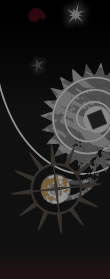Wikipedia on Gothic Lit

I know, Wikipedia? But for the casual researcher (like me hearing some tidbit of info and wanting to know more about it), Wikipedia is where we go. If it's important I verify it elsewhere, but otherwise I just go...hmmm interesting.
So, if I were casually interested in Gothic Lit, what would I learn from Wikipedia?
Gothic fiction (sometimes referred to asGothic horror) is a genre of literature that combines elements of both horror andromance. As a genre, it is generally believed to have been invented by the English author Horace Walpole, with his 1764 novel The Castle of Otranto.
I am very sorry to say that I owned and read Castle of Otranto in my second or third year of college, that I sold it back to the bookstore. I believe this was because it was in a compilation three book in one type deal, and I hate those as a reader.
The effect of Gothic fiction feeds on a pleasing sort of terror, an extension ofRomantic literary pleasures that were relatively new at the time of Walpole's novel. Gothic literature is intimately associated with the Gothic Revival architecture of the same era. In a way similar to the gothic revivalists' rejection of the clarity and rationalism of the neoclassical style of the Enlightened Establishment, the literary Gothic embodies an appreciation of the joys of extreme emotion, the thrills of fearfulness and awe inherent in the sublime, and a quest for atmosphere. The ruins of gothic buildings gave rise to multiple linked emotions by representing the inevitable decay and collapse of human creations—thus the urge to add fake ruins as eyecatchers in English landscape parks. English Gothic writers often associated medieval buildings with what they saw as a dark and terrifying period, characterized by harsh laws enforced by torture, and with mysterious, fantastic, and superstitious rituals. In literature such Anti-Catholicism had a European dimension featuring Roman Catholic excesses such as the Inquisition ).
Okay, I have to admit that I LOVE this whole section, because I love atmosphere. I also love that idea of adding ruins into places to add interest...that's exactly what I was writing about last week, how the ruined hotel next door to our resort added so much texture and interest to my balcony view. How I love old stuff, and ruined stuff. Takes me back to my two week European whirlwind tour, the castles, the torture museums, the castles, the catacombs, more castles...some people whom I am married to were sick of castles, but I have to admit, I have no idea how anyone ever gets sick of castles...(once my new scanner gets here I can put some of my awesome castle photos online, yay summer project!)
Prominent features of Gothic fiction include terror (both psychological and physical), mystery, thesupernatural, ghosts, haunted houses and Gothic architecture, castles, darkness, death, decay,doubles, madness, secrets, and hereditary curses. OMG, I am so excited to report that I have all of these in The Fall (thanks Mr. Poe!) and all of them in either one or the other of my works in progress.
The stock characters of Gothic fiction include tyrants, villains, bandits, maniacs, Byronic heroes,persecuted maidens, femmesfatales, monks, nuns, madwomen, magicians, vampires, werewolves,monsters, demons, angels, fallen angels, revenants, ghosts, perambulating skeletons, theWandering Jew and the Devil himself. Sadly, I have to report that I have no perambulating skeletons. The middle of this list could be pulled right out of the shelves of popular paranormal lit, couldn't it? Except I think that instead of falling for the vampire you're supposed to fall for the Byronic hero. Still, it's interesting to see that these elements that have been used by so many other types of fiction were stock characters of Gothic Fiction.
Labels: definitions, gothic fiction
|







3 Comments:
awesome post. I love all the madness and spooky castles and secrest and love. Very appealing. I am not such a fan of supernatural beings though...(all the paranormal stuff) although I'm sure I could be converted if I had the right book in my hands.
Jaclyn Moriarty's latest book 'The Ghosts of Ashbury High' is a hilarious gothic. Very whimsical (as are all her books) - but it's probably a gothic-in-a-genre-of-it's-own b/c it's Jaclyn Moriarty and she writes like no other. I love her unique take on it.
Also looking forward to seeing your next work. I think gothic is going to get big :) I love how you said the ruined hotel next door added texture.
x
Oh - and Wikipedia is my first stop too ;)
come on, are you sure you can't add a perambulating skeleton or two to your WIP?
Personally I love Castle of Otranto, but I admit it's more weird and hilarious than scary. I recommend Matthew Lewis's The Monk for an early example of Gothic that is genuinely creepy and disturbing in parts.
Post a Comment
Subscribe to Post Comments [Atom]
<< Home